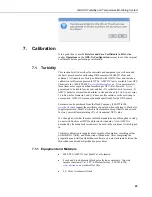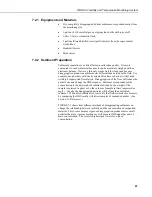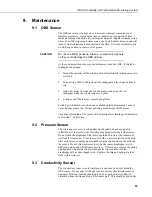
OBS-3A Turbidity and Temperature Monitoring System
3.
Prepare the next NTU standard and put the OBS-3A in it. Repeat steps 1
and 2 for all calibration values.
4.
After all calibration values have been recorded, click the
Calculate Fit
button.
5.
Look at the plot of residuals (blue line) which shows the differences
between the standard and computed NTU values. The average residual
magnitude should be less than 1% of calibration range of 2000 NTU
(maximum minus minimum NTU values) should produce an average
residual less than 20 NTU. Residuals higher than 1% of the calibration
range indicate that errors were made in the procedure. By inspecting the
plot of residuals, you can decide which values to repeat or delete. Repeat
values using the procedures described above.
6.
Once satisfied with the calibration, click the
Calculate Fit
button and
make a final quality check.
7.
Use the
Done/Exit
button to keep the new calibration and leave the
Calibration screen. Press the
Restore Original Cal
button to restore the
original calibration and leave the calibration screen. This restores the
calibration before you entered the Calibration screen. There is no way to
restore the original factory calibration.
Once you leave the Calibration screen, you will not be
able to restore the original calibration.
WARNING
7.1.4 Making Turbidity Standards
1.
For the zero NTU calibration point you will need a black 20 x 14 x 16 in.
container filled with clean tap water. A Rubbermaid® plastic storage box
makes a suitable container.
2.
For calibrations from 50-250 NTU use a 6 in. diameter container with 2
liters of filtered water or a premixed standard. Hold the sensor in the
container so the beam looks down and across the diameter to prevent the
beam from reflecting off the wall.
3.
A 4 in. diameter container can be used for solutions of
≥
250 NTUs. Add
one liter of filtered water and the necessary amount of formazin. See
TABLE 7-1 or the formula below for the preparation of standards.
4.
Stir the formazin solution with the spoon and position the OBS-3A in the
standard.
5.
Go to Step 2 of HydroSci Software Steps (Section 7.1.3,
HydroSci
Software Steps
).
45






























